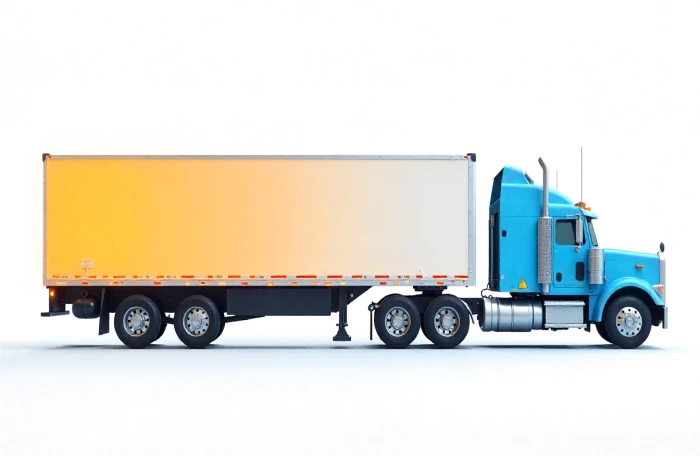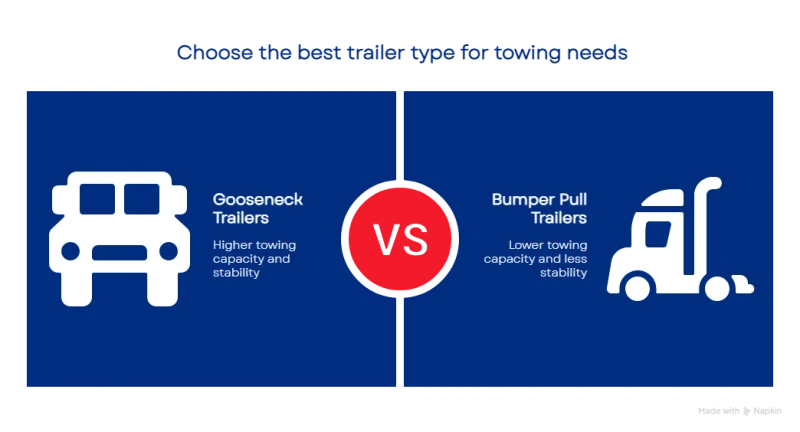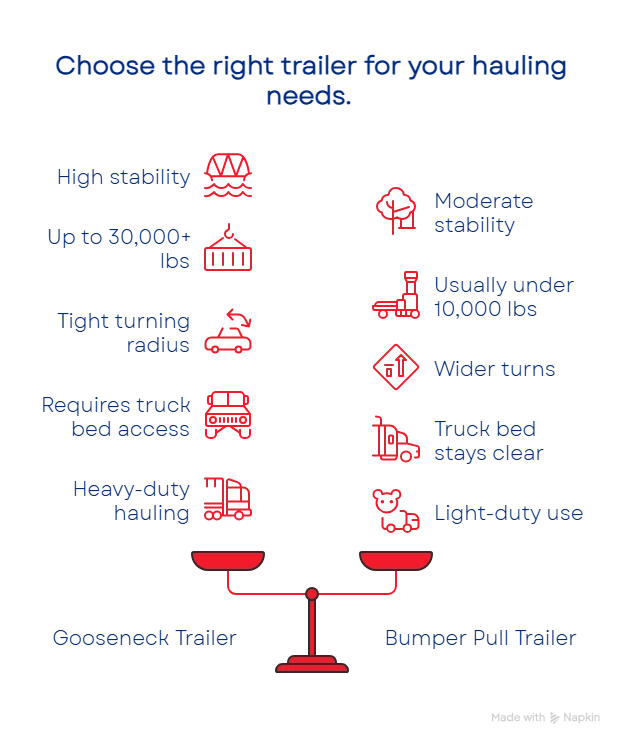Experienced haulers often choose gooseneck trailers instead of bumper pull models. The difference isn’t minor.
According to the TrailerLife Towing Guide, gooseneck trailers can tow up to 10,000 pounds more than most bumper pull trailers.
The wrong trailer setup can cause trailer sway, limit load capacity, and reduce control on the road.
What You’ll Learn
Before you choose a trailer, it's helpful to understand what each type is designed to handle. In this article, you’ll learn:
What a gooseneck trailer is and how it’s different from a bumper pull
Why many haulers rely on gooseneck trailers for heavy loads
How to decide if a gooseneck setup fits your hauling needs
Summary
A gooseneck trailer is a heavy-duty trailer designed with a long, curved front section, resembling a goose’s neck that extends over and attaches to a truck bed using a specialized hitch. This distinctive design is a significant advancement over traditional bumper-pull trailers and is widely used in the U.S. for hauling larger, heavier, or bulky loads.
Key Features
Hitch Design: The gooseneck trailer connects to a ball hitch installed in the bed of a pickup truck, directly over or slightly in front of the rear axle, rather than to a hitch at the rear bumper. This over-bed connection gives the trailer its name and ensures greater stability by properly distributing tongue weight over the truck’s suspension.
Load Capacity: Gooseneck trailers typically haul much heavier loads, often between 14,000 and 30,000 lbs, compared to bumper-pull trailers, which rarely exceed 10,000 lbs. Some of the largest models are over 40 feet long and can carry more than 25,000 lbs. of cargo.
Stability and Maneuverability: By situating the hitch weight over the rear axle, goosenecks are much less prone to sway, offer smoother handling, and accommodate tighter turns. These are key benefits for drivers hauling heavy or awkward loads.
Truck Requirements: Towing a gooseneck trailer requires a pickup truck with a reinforced bed and a dedicated gooseneck hitch mount installed. Many new trucks offer gooseneck hitch prep packages, but aftermarket installs are also standard.
Advantages vs. Other Trailers
Common Uses
Construction and heavy machinery transport
Livestock and horse trailers
Agricultural equipment
Hauling cars, boats, or large items for commercial use
The Wrong Key for the Right Lock
Choosing the wrong trailer is like using a key that almost fits but can’t unlock the door. It might turn slightly, but it won’t get the job done. Forcing it can cause damage.
That’s what happens when someone assumes all trailers work the same or chooses one based solely on cost. The type of hitch you choose affects how much weight you can carry, how your truck handles turns, and how safe your load stays during transport.
Not every trailer is built for the same kind of work. The goal is to match the trailer to the job.
What Is a Gooseneck Trailer?
A gooseneck trailer is a type of heavy-duty trailer designed for hauling large or heavy loads. It connects to a ball hitch mounted in the bed of a pickup truck, directly above the rear axle.
The trailer’s neck extends forward and curves into the bed, shifting weight toward the truck’s center. This improves balance and handling during transport.
Gooseneck trailers use a coupling system that connects to a ball hitch inside the truck bed, which improves stability and allows safer transport of heavy or oversized loads, even on rough roads or tight turns.
Gooseneck trailers are commonly used in farming, construction, and commercial hauling. Their design supports long-distance towing and frequent use under load.
Key Features That Make Gooseneck Trailers Different
Hitch design
Gooseneck trailers connect using a ball hitch that mounts in the center of the truck bed, above the rear axle. This location shifts more of the trailer’s weight forward, directly onto the truck’s frame. That difference in hitch placement increases towing stability and reduces rear-end sag compared to bumper pull trailers, which attach at the rear of the vehicle.
This setup requires climbing into the truck bed to connect or disconnect the trailer. Some haulers find that extra step worth it for the added control it provides on the road.
Load capacity
Gooseneck trailers are built for heavy loads. Most standard models support between 14,000 and 30,000 pounds. Some triple-axle models handle even more weight, particularly in equipment transport or livestock operations.
The design spreads weight more evenly across the trailer and truck. This makes it possible to carry larger or denser cargo without exceeding axle ratings. In contrast, bumper pull trailers often max out under 10,000 pounds and aren’t built for the same level of demand.
Stability and maneuverability
The hitch placement on a gooseneck gives it better road stability. It reduces sway at highway speeds, especially in wind or when passing large vehicles. The weight balance also helps when hauling uneven or shifting loads like livestock or stacked pallets.
Gooseneck trailers also have a tighter turning radius. This makes them easier to maneuver in confined areas like job sites, loading yards, or narrow farm roads. Backing up becomes more predictable once the driver becomes accustomed to how the trailer pivots within the truck bed space.
Truck requirements
To use a gooseneck trailer, the towing vehicle must be equipped with a gooseneck hitch system. These systems include a mounting kit and a ball hitch installed in the center of the truck bed.
Many modern heavy-duty pickups are factory-ready for a gooseneck setup. For older or mid-range models, qualified shops can install aftermarket kits safely. The truck bed must be structurally reinforced to handle the added stress, especially under full load.
Gooseneck vs. Bumper Pull: At-a-Glance Comparison
Different trailer types have specific strengths, and this complete guide to car transport trailers explains how to match trailer design to the job.
Common Uses of Gooseneck Trailers
Gooseneck trailers are used in industries that require reliable towing, high load capacity, and consistent performance in various road and weather conditions. Their design supports daily use, long-distance hauling, and better weight distribution, which makes them a practical choice for professional operations.
Agriculture: Farmers and ranchers use gooseneck trailers to move equipment, livestock, hay, fencing supplies, and feed. The trailer’s stability makes it effective on uneven terrain and in open fields. For livestock hauling, the reduced sway lowers stress on animals and decreases the risk of injury during transport.
Construction: Contractors rely on gooseneck trailers to move heavy materials and machinery between job sites. This includes skid steers, excavators, concrete forms, lumber, and generators. The tighter turning radius helps when navigating through busy or confined construction areas. Many gooseneck flatbeds are also used to stage tools and supplies directly on-site.
Auto transport: Gooseneck car haulers are used by dealerships, auction services, and specialty transport companies. They carry one or more vehicles at a time and can handle oversized or modified units that may not fit on standard trailers. The added deck length supports efficient loading with ramps or hydraulic lifts.
Livestock and horses: Horse owners and livestock producers use gooseneck trailers for routine transport, event travel, and medical relocation. The hitch design improves towing control, especially when hauling through rural roads, hills, or during sudden stops. Many models offer enclosed space with dividers, ventilation, and tack storage.
Commercial freight: Businesses that move freight use gooseneck trailers for deliveries that don’t require a full semi-truck. This includes palletized goods, oversized equipment, and materials for warehouses or retail operations. Gooseneck setups work well for small fleets and independent contractors who operate in tight areas or under flexible schedules.
For those comparing self-hauling with professional vehicle transport, it may help to review current rates using a car shipping quote calculator to understand the cost difference.
Final Thoughts
Gooseneck trailers are designed for stability, higher weight capacity, and improved handling. Their hitch design shifts the load toward the truck’s center, making them more suitable for demanding hauling tasks.
If you regularly transport equipment, vehicles, livestock, or bulk materials, a gooseneck setup may be a more dependable option. Before choosing one, confirm your truck can support the hitch system and matches the trailer’s weight requirements.
Taking time to match the trailer type to your hauling needs can improve safety and long-term performance.
Need Help Shipping Your Car?
If you’re looking for a way to transport your vehicle, AmeriFreight Car Shipping works with licensed carriers to arrange safe and efficient auto transport.
We offer open and enclosed trailer options, depending on your needs.
Frequently Asked Questions (FAQs)
What are some common issues or problems that gooseneck trailer owners experience?
Hitch alignment, brake wear, wiring problems, and cracked welds can occur with regular use.
How do you properly store a gooseneck trailer when it's not in use?
Park on level ground, inflate tires, use chocks, and cover the hitch. Store under cover if possible.
Can a gooseneck trailer be used for hauling horses or other livestock?
Yes. Many livestock trailers use a gooseneck design for added stability and control.
What kind of regular maintenance does a gooseneck trailer require?
Check tires, brakes, lights, hitch components, and the frame. Lubricate parts and inspect regularly.
Disclaimer: This article is for general informational purposes only. Always consult a qualified professional before making decisions related to trailer purchase, towing equipment, or hauling safety.






















